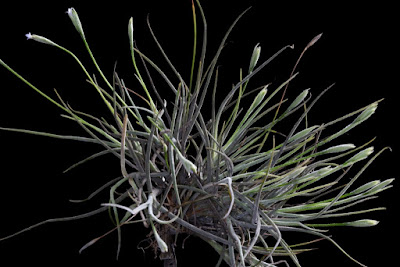Tillandsia recurvata is native to the southern US, where it stretches from Florida all the way to Arizona, and as far south as Argentina and Chile. It grows epiphytically on trees, bushes, and cacti or as a pterophyte on rocky cliffs at altitudes ranging from 0 to just over 3000 meters.
Tillandsia recurvata, also called as Small ball moss, Ball moss, Renealmia recurvata, Diaphoranthema recurvata, Tillandsia monostachya, Tillandsia uniflora, Diaphoranthema uniflora, Tillandsia pauciflora, is a species of the genus Tillandsia. This species was described by Carl Linnaeus in 1762.
IDENTIFY TILLANDSIA RECURVATA AIR PLANT
Tillandsia recurvata is native to the southern US, where it stretches from Florida all the way to Arizona, and as far south as Argentina and Chile. It grows epiphytically on trees, bushes, and cacti or as a pterophyte on rocky cliffs at altitudes ranging from 0 to just over 3000 meters.
It is a small sized caulescent with fine stem and sometimes slightly branched, fast growing, which can quickly form dense tufts and has numerous, supple, distichous leaves. The sheaths are thin, oval, glabrous at the base (sometimes with a ciliated margin), nested, surrounding the stem. The limbs are cylindrical, more or less long and curved depending on the origin of the plant.
This air plant bloom from the simple inflorescence, with a small spike arranged at the end of a thin and scaly peduncle, with very few flowers (sometimes only one). The bracts of the flowering stem are green, scaly, linear. The floral bracts are similar to the bracts of the flowering stem but smaller and slightly ribbed. The flowers are sessile, tiny (3 mm wide), non-tubular, mauve or purple, sometimes pinkish. The stamens and pistil are included.
Ball moss is variable and widely distributed, it can easily be confused with other Tillandsia species, such as Tillandsia capillaris, Tillandsia crocata, and Tillandsia mallemontii, which are found in similar habitats but which have different flower characteristics.
TILLANDSIA RECURVATA AIR PLANT CARE AND CULTURE
Cultural information should only be used as a guide, and should be to be adapted to suit you. Your physical location; where you grow your plants, how much time you have to devote to their care, and many other factors, will need to be taken into account. Only then can you decide on the cultural methods that best suit you and your plants.
Light:
Tillandsia recurvata requires good light, avoiding full sun if possible. When moving the plants outdoors, gradually accustom them to increased light levels, that because when shifted to bright light too quickly, their leaves can sunburn.
Temperature:
The required temperature ranging from 10 to 32°C. Get it early enough in the fall if you grow it outside, so that it does not face night temperatures below 4 or 5 ° C, especially if it is wet. It is sensitive to freezing, particularly when moist. The plants can faced temperatures close to 0 ° C (sheltered and dry) for a few hours without damage.
Humidity:
Ball moss need the moderate to high level of humidity. This species likes frequent sprays if ventilation allows it. Good aeration is required, the plant must dry quickly (in less than an hour).
Substrate, growing media and repotting:
Tillandsia recurvata can grow suspended or to be mounted on a solid substrate that does not retain water. Place the plant very close to a window indoors in winter and preferably out in mid-shade in the summer. You can glue the plant directly to the surface with a strong adhesive, or you can wire the plant to the base. Don't cover the base of the plant with moss or it may rot. It can be grown on almost any imaginable decorative mount, including shells, rocks, slate, driftwood, etc.
Watering:
Twice or 3 times a week in summer, once or 2 times a week in winter according to the luminosity and the ambient humidity. Obviously when it rains and if you grow it outside, it counts as a watering. Some growers prefer the bath to the spray to water this species, especially if the plant is already dense. Watch for leaf tips and increase the frequency of watering if they appear dry.
Fertilizer:
This air plant does not require fertilizing. However, it can be fertilized with the moderate doses to speed up the growth. 1 to 2 times a month in the summer and 1 time a month in the winter.















COMMENTS